PhD Research Proposal: Young Muslims Identity Formation in Australia
VerifiedAdded on 2021/04/21
|36
|9403
|57
Project
AI Summary
This research proposal, submitted to the University of South Australia, investigates the multifaceted identity formation of young Muslims in Australia, with a particular emphasis on the dynamics of Shiite-Sunni relationships. It delves into the historical context of Islam in Australia, migration patterns, and the impact of events like the Arab Spring on Muslim communities. The study aims to explore how these relationships influence the experiences of Muslim youth attending Adelaide Islamic schools, their interactions with non-Muslims, and their academic performance. The proposal outlines the research questions, literature review, theoretical framework, and methodology, including participant selection and data analysis techniques, to provide a comprehensive understanding of the subject. The research further seeks to understand the impact of Shiite-Sunni relations on the academic performance of students in Islamic schools and how these relationships affect their interactions with youth from non-Muslim Australian schools.
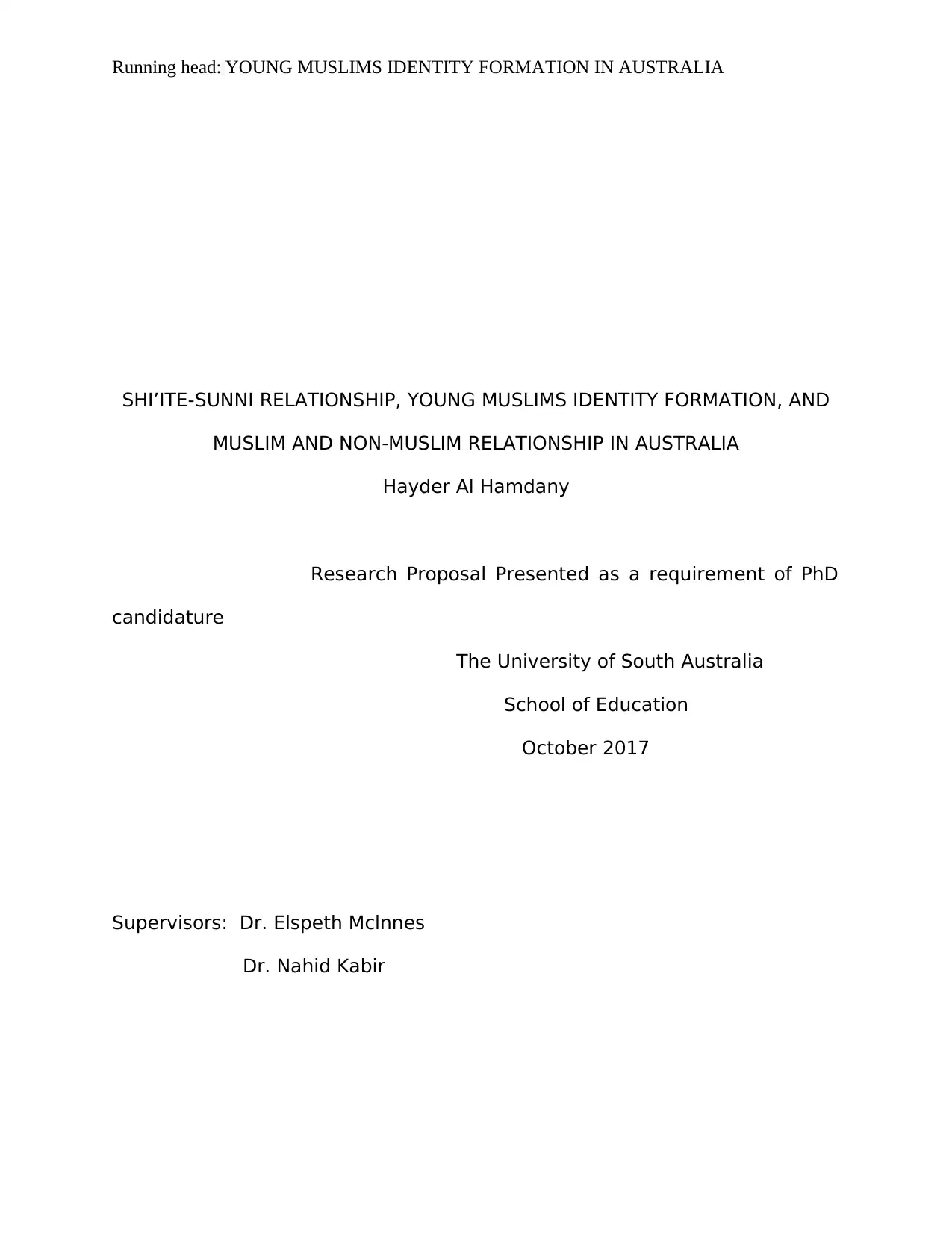
Running head: YOUNG MUSLIMS IDENTITY FORMATION IN AUSTRALIA
SHI’ITE-SUNNI RELATIONSHIP, YOUNG MUSLIMS IDENTITY FORMATION, AND
MUSLIM AND NON-MUSLIM RELATIONSHIP IN AUSTRALIA
Hayder Al Hamdany
Research Proposal Presented as a requirement of PhD
candidature
The University of South Australia
School of Education
October 2017
Supervisors: Dr. Elspeth Mclnnes
Dr. Nahid Kabir
SHI’ITE-SUNNI RELATIONSHIP, YOUNG MUSLIMS IDENTITY FORMATION, AND
MUSLIM AND NON-MUSLIM RELATIONSHIP IN AUSTRALIA
Hayder Al Hamdany
Research Proposal Presented as a requirement of PhD
candidature
The University of South Australia
School of Education
October 2017
Supervisors: Dr. Elspeth Mclnnes
Dr. Nahid Kabir
Paraphrase This Document
Need a fresh take? Get an instant paraphrase of this document with our AI Paraphraser
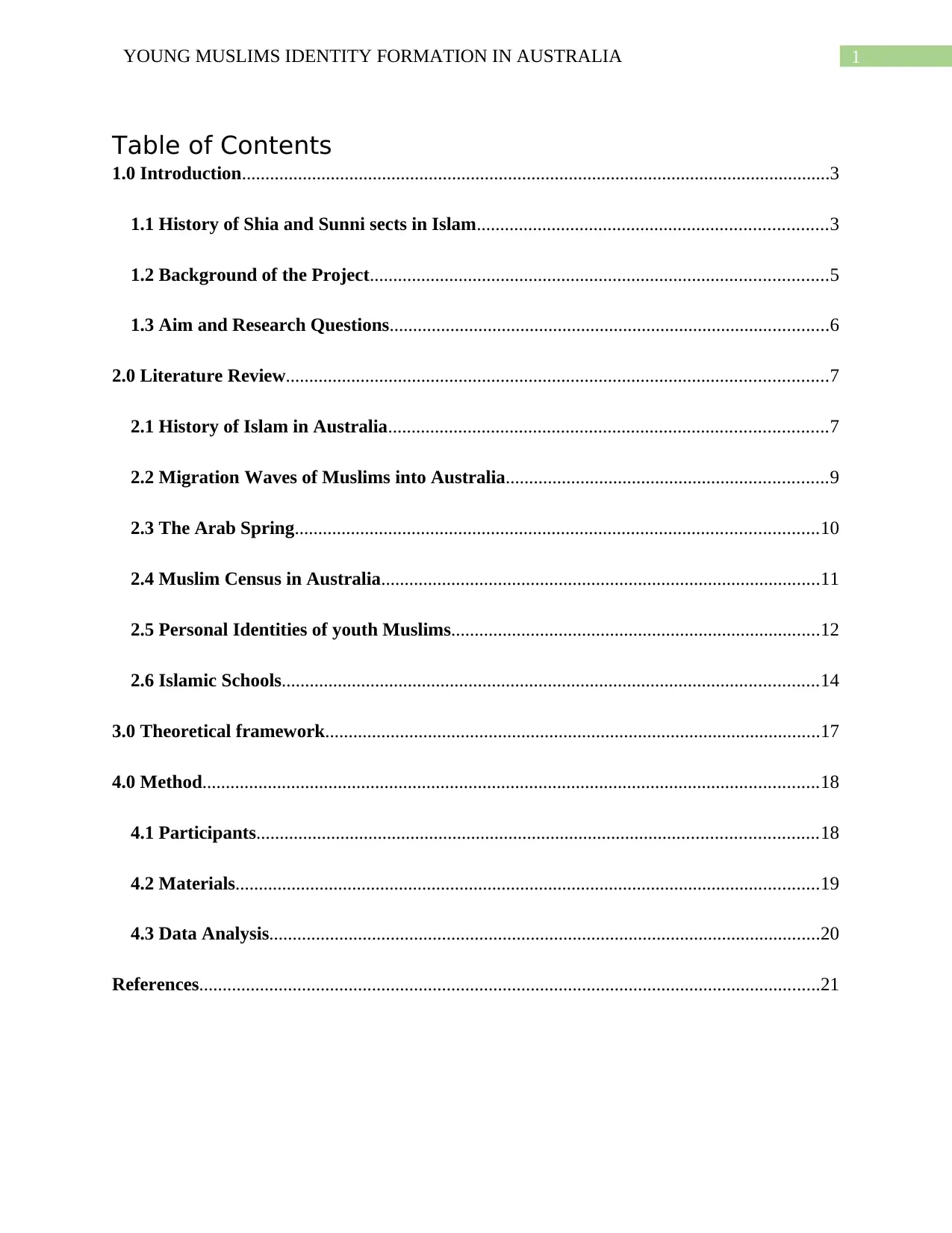
1YOUNG MUSLIMS IDENTITY FORMATION IN AUSTRALIA
Table of Contents
1.0 Introduction..............................................................................................................................3
1.1 History of Shia and Sunni sects in Islam...........................................................................3
1.2 Background of the Project..................................................................................................5
1.3 Aim and Research Questions..............................................................................................6
2.0 Literature Review....................................................................................................................7
2.1 History of Islam in Australia..............................................................................................7
2.2 Migration Waves of Muslims into Australia.....................................................................9
2.3 The Arab Spring................................................................................................................10
2.4 Muslim Census in Australia..............................................................................................11
2.5 Personal Identities of youth Muslims...............................................................................12
2.6 Islamic Schools...................................................................................................................14
3.0 Theoretical framework..........................................................................................................17
4.0 Method....................................................................................................................................18
4.1 Participants........................................................................................................................18
4.2 Materials.............................................................................................................................19
4.3 Data Analysis......................................................................................................................20
References.....................................................................................................................................21
Table of Contents
1.0 Introduction..............................................................................................................................3
1.1 History of Shia and Sunni sects in Islam...........................................................................3
1.2 Background of the Project..................................................................................................5
1.3 Aim and Research Questions..............................................................................................6
2.0 Literature Review....................................................................................................................7
2.1 History of Islam in Australia..............................................................................................7
2.2 Migration Waves of Muslims into Australia.....................................................................9
2.3 The Arab Spring................................................................................................................10
2.4 Muslim Census in Australia..............................................................................................11
2.5 Personal Identities of youth Muslims...............................................................................12
2.6 Islamic Schools...................................................................................................................14
3.0 Theoretical framework..........................................................................................................17
4.0 Method....................................................................................................................................18
4.1 Participants........................................................................................................................18
4.2 Materials.............................................................................................................................19
4.3 Data Analysis......................................................................................................................20
References.....................................................................................................................................21
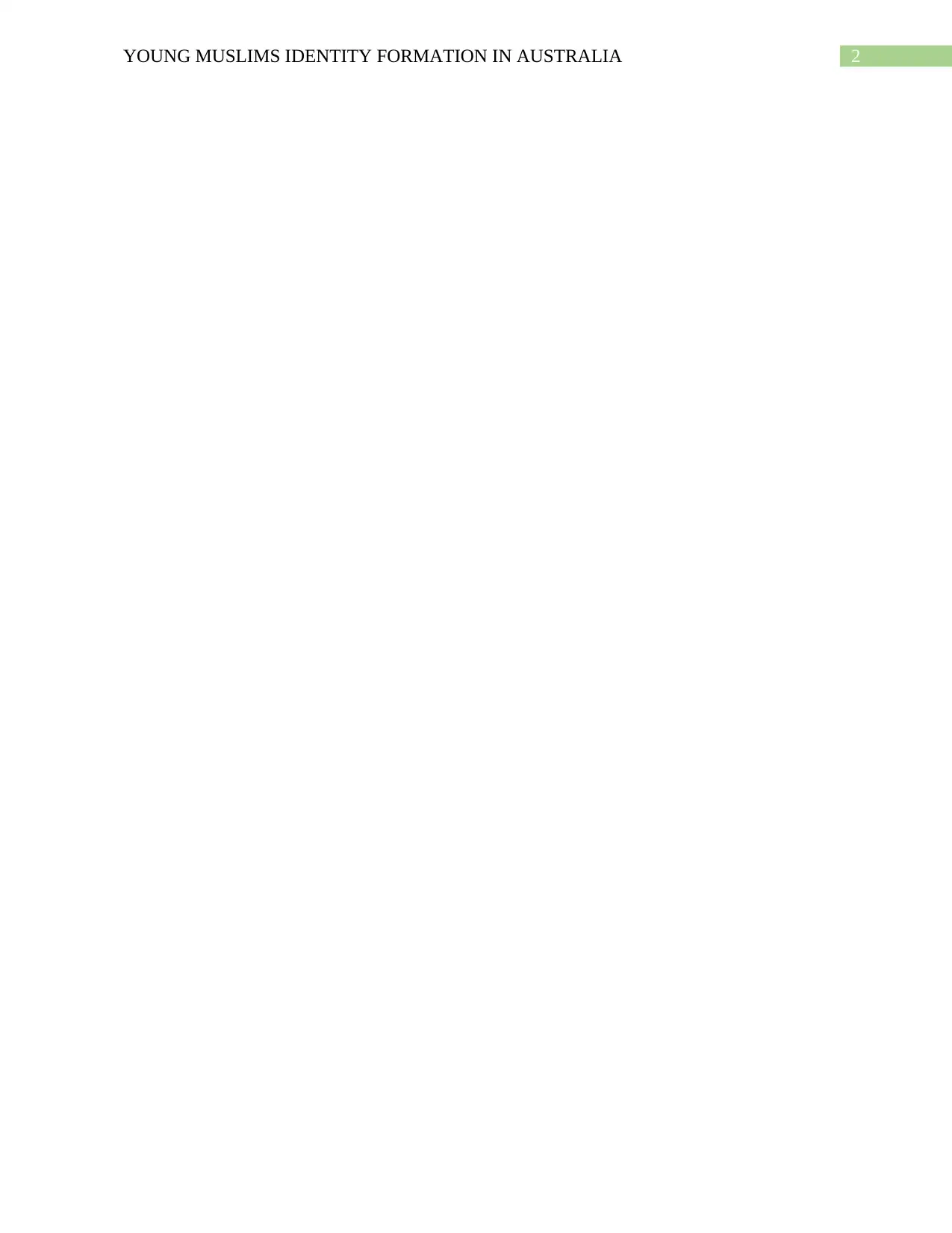
2YOUNG MUSLIMS IDENTITY FORMATION IN AUSTRALIA
⊘ This is a preview!⊘
Do you want full access?
Subscribe today to unlock all pages.

Trusted by 1+ million students worldwide
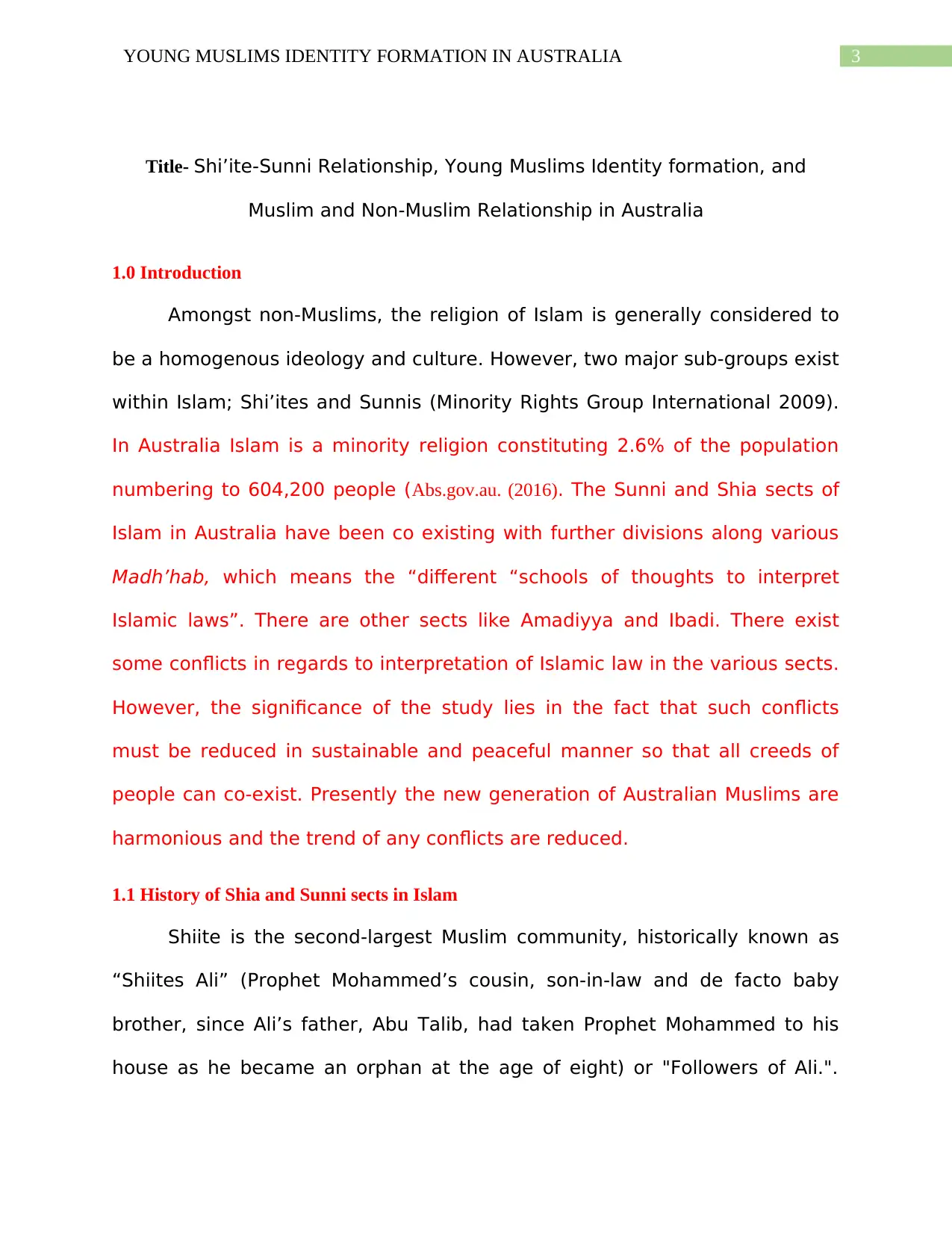
3YOUNG MUSLIMS IDENTITY FORMATION IN AUSTRALIA
Title- Shi’ite-Sunni Relationship, Young Muslims Identity formation, and
Muslim and Non-Muslim Relationship in Australia
1.0 Introduction
Amongst non-Muslims, the religion of Islam is generally considered to
be a homogenous ideology and culture. However, two major sub-groups exist
within Islam; Shi’ites and Sunnis (Minority Rights Group International 2009).
In Australia Islam is a minority religion constituting 2.6% of the population
numbering to 604,200 people (Abs.gov.au. (2016). The Sunni and Shia sects of
Islam in Australia have been co existing with further divisions along various
Madh’hab, which means the “different “schools of thoughts to interpret
Islamic laws”. There are other sects like Amadiyya and Ibadi. There exist
some conflicts in regards to interpretation of Islamic law in the various sects.
However, the significance of the study lies in the fact that such conflicts
must be reduced in sustainable and peaceful manner so that all creeds of
people can co-exist. Presently the new generation of Australian Muslims are
harmonious and the trend of any conflicts are reduced.
1.1 History of Shia and Sunni sects in Islam
Shiite is the second-largest Muslim community, historically known as
“Shiites Ali” (Prophet Mohammed’s cousin, son-in-law and de facto baby
brother, since Ali’s father, Abu Talib, had taken Prophet Mohammed to his
house as he became an orphan at the age of eight) or "Followers of Ali.".
Title- Shi’ite-Sunni Relationship, Young Muslims Identity formation, and
Muslim and Non-Muslim Relationship in Australia
1.0 Introduction
Amongst non-Muslims, the religion of Islam is generally considered to
be a homogenous ideology and culture. However, two major sub-groups exist
within Islam; Shi’ites and Sunnis (Minority Rights Group International 2009).
In Australia Islam is a minority religion constituting 2.6% of the population
numbering to 604,200 people (Abs.gov.au. (2016). The Sunni and Shia sects of
Islam in Australia have been co existing with further divisions along various
Madh’hab, which means the “different “schools of thoughts to interpret
Islamic laws”. There are other sects like Amadiyya and Ibadi. There exist
some conflicts in regards to interpretation of Islamic law in the various sects.
However, the significance of the study lies in the fact that such conflicts
must be reduced in sustainable and peaceful manner so that all creeds of
people can co-exist. Presently the new generation of Australian Muslims are
harmonious and the trend of any conflicts are reduced.
1.1 History of Shia and Sunni sects in Islam
Shiite is the second-largest Muslim community, historically known as
“Shiites Ali” (Prophet Mohammed’s cousin, son-in-law and de facto baby
brother, since Ali’s father, Abu Talib, had taken Prophet Mohammed to his
house as he became an orphan at the age of eight) or "Followers of Ali.".
Paraphrase This Document
Need a fresh take? Get an instant paraphrase of this document with our AI Paraphraser
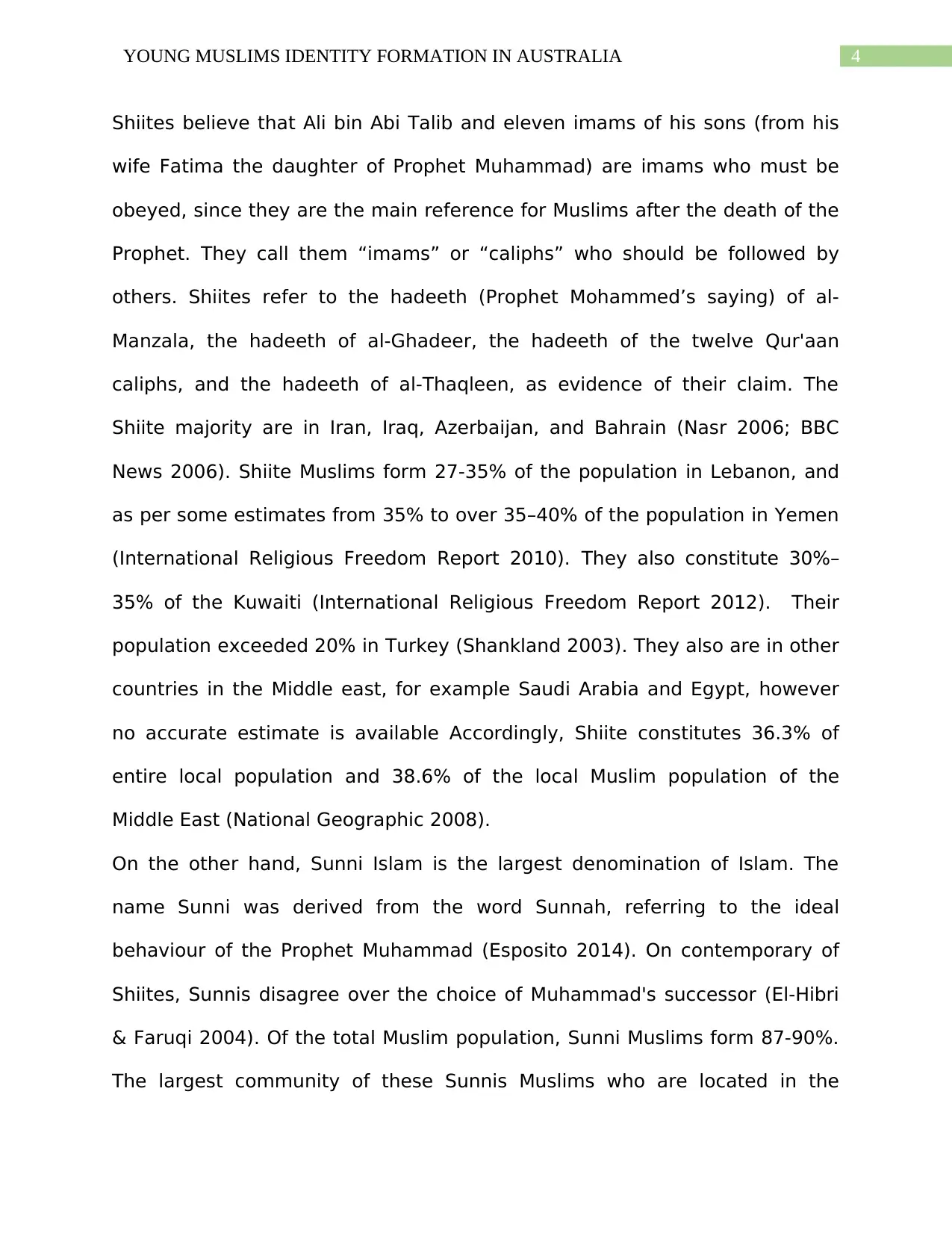
4YOUNG MUSLIMS IDENTITY FORMATION IN AUSTRALIA
Shiites believe that Ali bin Abi Talib and eleven imams of his sons (from his
wife Fatima the daughter of Prophet Muhammad) are imams who must be
obeyed, since they are the main reference for Muslims after the death of the
Prophet. They call them “imams” or “caliphs” who should be followed by
others. Shiites refer to the hadeeth (Prophet Mohammed’s saying) of al-
Manzala, the hadeeth of al-Ghadeer, the hadeeth of the twelve Qur'aan
caliphs, and the hadeeth of al-Thaqleen, as evidence of their claim. The
Shiite majority are in Iran, Iraq, Azerbaijan, and Bahrain (Nasr 2006; BBC
News 2006). Shiite Muslims form 27-35% of the population in Lebanon, and
as per some estimates from 35% to over 35–40% of the population in Yemen
(International Religious Freedom Report 2010). They also constitute 30%–
35% of the Kuwaiti (International Religious Freedom Report 2012). Their
population exceeded 20% in Turkey (Shankland 2003). They also are in other
countries in the Middle east, for example Saudi Arabia and Egypt, however
no accurate estimate is available Accordingly, Shiite constitutes 36.3% of
entire local population and 38.6% of the local Muslim population of the
Middle East (National Geographic 2008).
On the other hand, Sunni Islam is the largest denomination of Islam. The
name Sunni was derived from the word Sunnah, referring to the ideal
behaviour of the Prophet Muhammad (Esposito 2014). On contemporary of
Shiites, Sunnis disagree over the choice of Muhammad's successor (El-Hibri
& Faruqi 2004). Of the total Muslim population, Sunni Muslims form 87-90%.
The largest community of these Sunnis Muslims who are located in the
Shiites believe that Ali bin Abi Talib and eleven imams of his sons (from his
wife Fatima the daughter of Prophet Muhammad) are imams who must be
obeyed, since they are the main reference for Muslims after the death of the
Prophet. They call them “imams” or “caliphs” who should be followed by
others. Shiites refer to the hadeeth (Prophet Mohammed’s saying) of al-
Manzala, the hadeeth of al-Ghadeer, the hadeeth of the twelve Qur'aan
caliphs, and the hadeeth of al-Thaqleen, as evidence of their claim. The
Shiite majority are in Iran, Iraq, Azerbaijan, and Bahrain (Nasr 2006; BBC
News 2006). Shiite Muslims form 27-35% of the population in Lebanon, and
as per some estimates from 35% to over 35–40% of the population in Yemen
(International Religious Freedom Report 2010). They also constitute 30%–
35% of the Kuwaiti (International Religious Freedom Report 2012). Their
population exceeded 20% in Turkey (Shankland 2003). They also are in other
countries in the Middle east, for example Saudi Arabia and Egypt, however
no accurate estimate is available Accordingly, Shiite constitutes 36.3% of
entire local population and 38.6% of the local Muslim population of the
Middle East (National Geographic 2008).
On the other hand, Sunni Islam is the largest denomination of Islam. The
name Sunni was derived from the word Sunnah, referring to the ideal
behaviour of the Prophet Muhammad (Esposito 2014). On contemporary of
Shiites, Sunnis disagree over the choice of Muhammad's successor (El-Hibri
& Faruqi 2004). Of the total Muslim population, Sunni Muslims form 87-90%.
The largest community of these Sunnis Muslims who are located in the
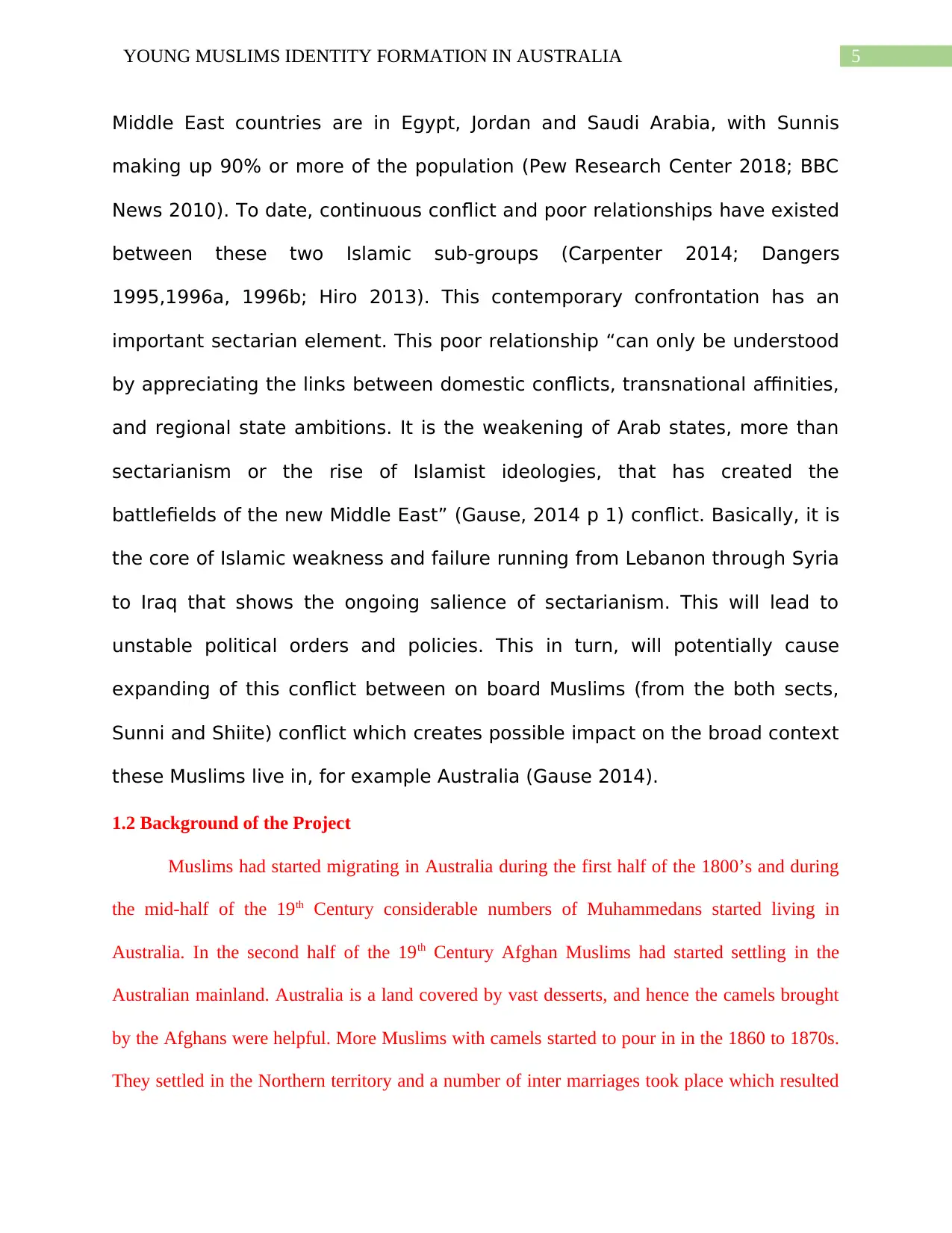
5YOUNG MUSLIMS IDENTITY FORMATION IN AUSTRALIA
Middle East countries are in Egypt, Jordan and Saudi Arabia, with Sunnis
making up 90% or more of the population (Pew Research Center 2018; BBC
News 2010). To date, continuous conflict and poor relationships have existed
between these two Islamic sub-groups (Carpenter 2014; Dangers
1995,1996a, 1996b; Hiro 2013). This contemporary confrontation has an
important sectarian element. This poor relationship “can only be understood
by appreciating the links between domestic conflicts, transnational affinities,
and regional state ambitions. It is the weakening of Arab states, more than
sectarianism or the rise of Islamist ideologies, that has created the
battlefields of the new Middle East” (Gause, 2014 p 1) conflict. Basically, it is
the core of Islamic weakness and failure running from Lebanon through Syria
to Iraq that shows the ongoing salience of sectarianism. This will lead to
unstable political orders and policies. This in turn, will potentially cause
expanding of this conflict between on board Muslims (from the both sects,
Sunni and Shiite) conflict which creates possible impact on the broad context
these Muslims live in, for example Australia (Gause 2014).
1.2 Background of the Project
Muslims had started migrating in Australia during the first half of the 1800’s and during
the mid-half of the 19th Century considerable numbers of Muhammedans started living in
Australia. In the second half of the 19th Century Afghan Muslims had started settling in the
Australian mainland. Australia is a land covered by vast desserts, and hence the camels brought
by the Afghans were helpful. More Muslims with camels started to pour in in the 1860 to 1870s.
They settled in the Northern territory and a number of inter marriages took place which resulted
Middle East countries are in Egypt, Jordan and Saudi Arabia, with Sunnis
making up 90% or more of the population (Pew Research Center 2018; BBC
News 2010). To date, continuous conflict and poor relationships have existed
between these two Islamic sub-groups (Carpenter 2014; Dangers
1995,1996a, 1996b; Hiro 2013). This contemporary confrontation has an
important sectarian element. This poor relationship “can only be understood
by appreciating the links between domestic conflicts, transnational affinities,
and regional state ambitions. It is the weakening of Arab states, more than
sectarianism or the rise of Islamist ideologies, that has created the
battlefields of the new Middle East” (Gause, 2014 p 1) conflict. Basically, it is
the core of Islamic weakness and failure running from Lebanon through Syria
to Iraq that shows the ongoing salience of sectarianism. This will lead to
unstable political orders and policies. This in turn, will potentially cause
expanding of this conflict between on board Muslims (from the both sects,
Sunni and Shiite) conflict which creates possible impact on the broad context
these Muslims live in, for example Australia (Gause 2014).
1.2 Background of the Project
Muslims had started migrating in Australia during the first half of the 1800’s and during
the mid-half of the 19th Century considerable numbers of Muhammedans started living in
Australia. In the second half of the 19th Century Afghan Muslims had started settling in the
Australian mainland. Australia is a land covered by vast desserts, and hence the camels brought
by the Afghans were helpful. More Muslims with camels started to pour in in the 1860 to 1870s.
They settled in the Northern territory and a number of inter marriages took place which resulted
⊘ This is a preview!⊘
Do you want full access?
Subscribe today to unlock all pages.

Trusted by 1+ million students worldwide
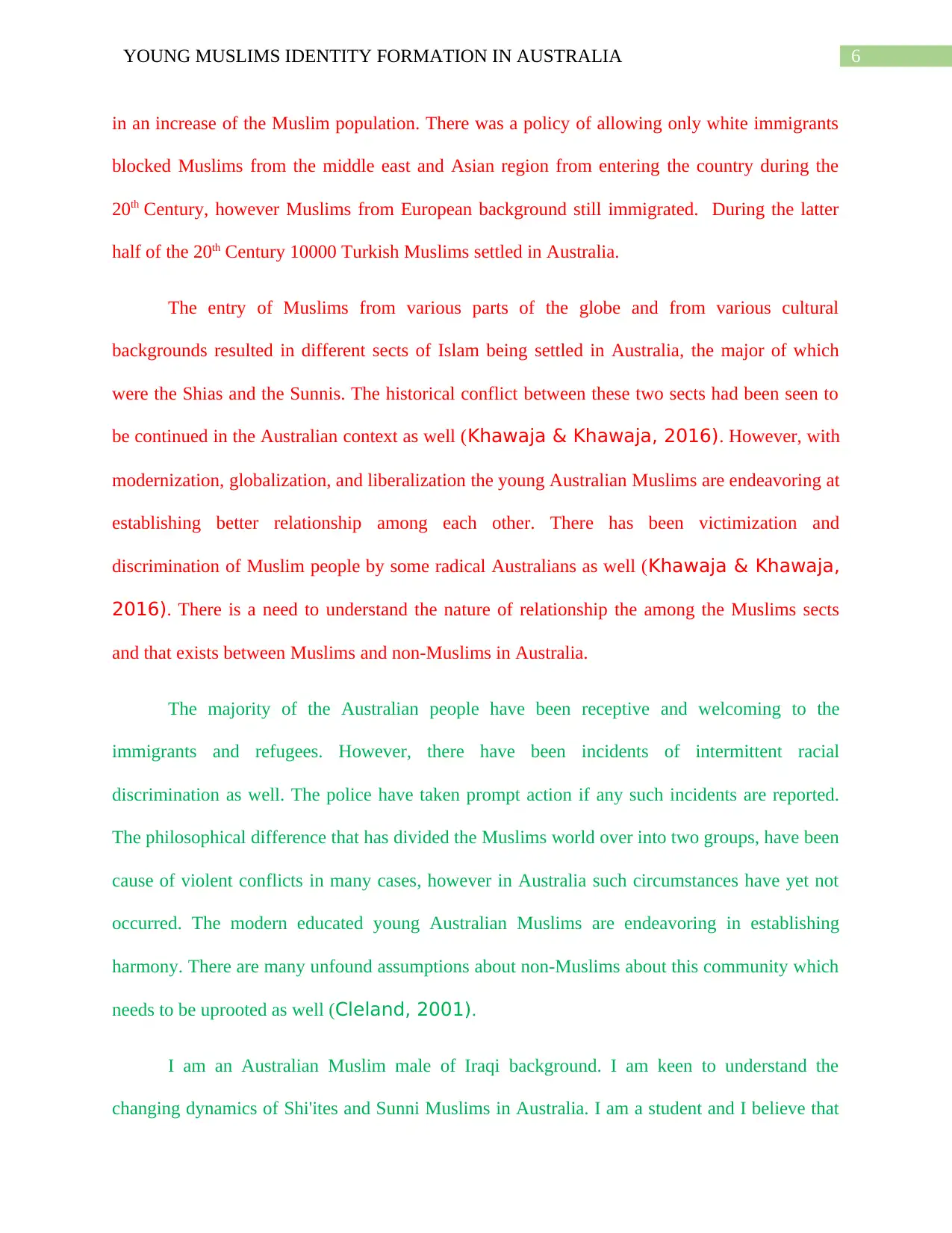
6YOUNG MUSLIMS IDENTITY FORMATION IN AUSTRALIA
in an increase of the Muslim population. There was a policy of allowing only white immigrants
blocked Muslims from the middle east and Asian region from entering the country during the
20th Century, however Muslims from European background still immigrated. During the latter
half of the 20th Century 10000 Turkish Muslims settled in Australia.
The entry of Muslims from various parts of the globe and from various cultural
backgrounds resulted in different sects of Islam being settled in Australia, the major of which
were the Shias and the Sunnis. The historical conflict between these two sects had been seen to
be continued in the Australian context as well (Khawaja & Khawaja, 2016). However, with
modernization, globalization, and liberalization the young Australian Muslims are endeavoring at
establishing better relationship among each other. There has been victimization and
discrimination of Muslim people by some radical Australians as well (Khawaja & Khawaja,
2016). There is a need to understand the nature of relationship the among the Muslims sects
and that exists between Muslims and non-Muslims in Australia.
The majority of the Australian people have been receptive and welcoming to the
immigrants and refugees. However, there have been incidents of intermittent racial
discrimination as well. The police have taken prompt action if any such incidents are reported.
The philosophical difference that has divided the Muslims world over into two groups, have been
cause of violent conflicts in many cases, however in Australia such circumstances have yet not
occurred. The modern educated young Australian Muslims are endeavoring in establishing
harmony. There are many unfound assumptions about non-Muslims about this community which
needs to be uprooted as well (Cleland, 2001).
I am an Australian Muslim male of Iraqi background. I am keen to understand the
changing dynamics of Shi'ites and Sunni Muslims in Australia. I am a student and I believe that
in an increase of the Muslim population. There was a policy of allowing only white immigrants
blocked Muslims from the middle east and Asian region from entering the country during the
20th Century, however Muslims from European background still immigrated. During the latter
half of the 20th Century 10000 Turkish Muslims settled in Australia.
The entry of Muslims from various parts of the globe and from various cultural
backgrounds resulted in different sects of Islam being settled in Australia, the major of which
were the Shias and the Sunnis. The historical conflict between these two sects had been seen to
be continued in the Australian context as well (Khawaja & Khawaja, 2016). However, with
modernization, globalization, and liberalization the young Australian Muslims are endeavoring at
establishing better relationship among each other. There has been victimization and
discrimination of Muslim people by some radical Australians as well (Khawaja & Khawaja,
2016). There is a need to understand the nature of relationship the among the Muslims sects
and that exists between Muslims and non-Muslims in Australia.
The majority of the Australian people have been receptive and welcoming to the
immigrants and refugees. However, there have been incidents of intermittent racial
discrimination as well. The police have taken prompt action if any such incidents are reported.
The philosophical difference that has divided the Muslims world over into two groups, have been
cause of violent conflicts in many cases, however in Australia such circumstances have yet not
occurred. The modern educated young Australian Muslims are endeavoring in establishing
harmony. There are many unfound assumptions about non-Muslims about this community which
needs to be uprooted as well (Cleland, 2001).
I am an Australian Muslim male of Iraqi background. I am keen to understand the
changing dynamics of Shi'ites and Sunni Muslims in Australia. I am a student and I believe that
Paraphrase This Document
Need a fresh take? Get an instant paraphrase of this document with our AI Paraphraser
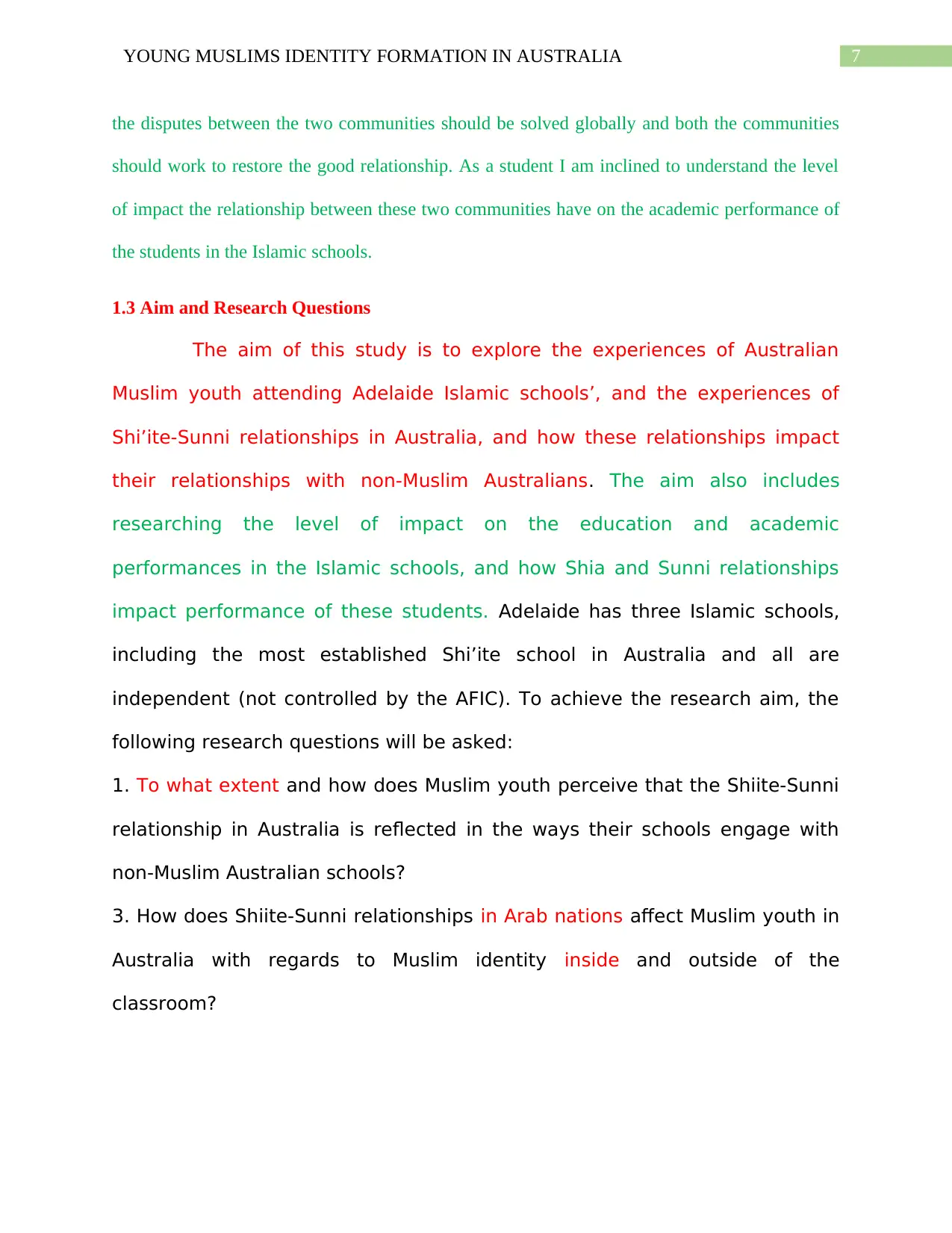
7YOUNG MUSLIMS IDENTITY FORMATION IN AUSTRALIA
the disputes between the two communities should be solved globally and both the communities
should work to restore the good relationship. As a student I am inclined to understand the level
of impact the relationship between these two communities have on the academic performance of
the students in the Islamic schools.
1.3 Aim and Research Questions
The aim of this study is to explore the experiences of Australian
Muslim youth attending Adelaide Islamic schools’, and the experiences of
Shi’ite-Sunni relationships in Australia, and how these relationships impact
their relationships with non-Muslim Australians. The aim also includes
researching the level of impact on the education and academic
performances in the Islamic schools, and how Shia and Sunni relationships
impact performance of these students. Adelaide has three Islamic schools,
including the most established Shi’ite school in Australia and all are
independent (not controlled by the AFIC). To achieve the research aim, the
following research questions will be asked:
1. To what extent and how does Muslim youth perceive that the Shiite-Sunni
relationship in Australia is reflected in the ways their schools engage with
non-Muslim Australian schools?
3. How does Shiite-Sunni relationships in Arab nations affect Muslim youth in
Australia with regards to Muslim identity inside and outside of the
classroom?
the disputes between the two communities should be solved globally and both the communities
should work to restore the good relationship. As a student I am inclined to understand the level
of impact the relationship between these two communities have on the academic performance of
the students in the Islamic schools.
1.3 Aim and Research Questions
The aim of this study is to explore the experiences of Australian
Muslim youth attending Adelaide Islamic schools’, and the experiences of
Shi’ite-Sunni relationships in Australia, and how these relationships impact
their relationships with non-Muslim Australians. The aim also includes
researching the level of impact on the education and academic
performances in the Islamic schools, and how Shia and Sunni relationships
impact performance of these students. Adelaide has three Islamic schools,
including the most established Shi’ite school in Australia and all are
independent (not controlled by the AFIC). To achieve the research aim, the
following research questions will be asked:
1. To what extent and how does Muslim youth perceive that the Shiite-Sunni
relationship in Australia is reflected in the ways their schools engage with
non-Muslim Australian schools?
3. How does Shiite-Sunni relationships in Arab nations affect Muslim youth in
Australia with regards to Muslim identity inside and outside of the
classroom?
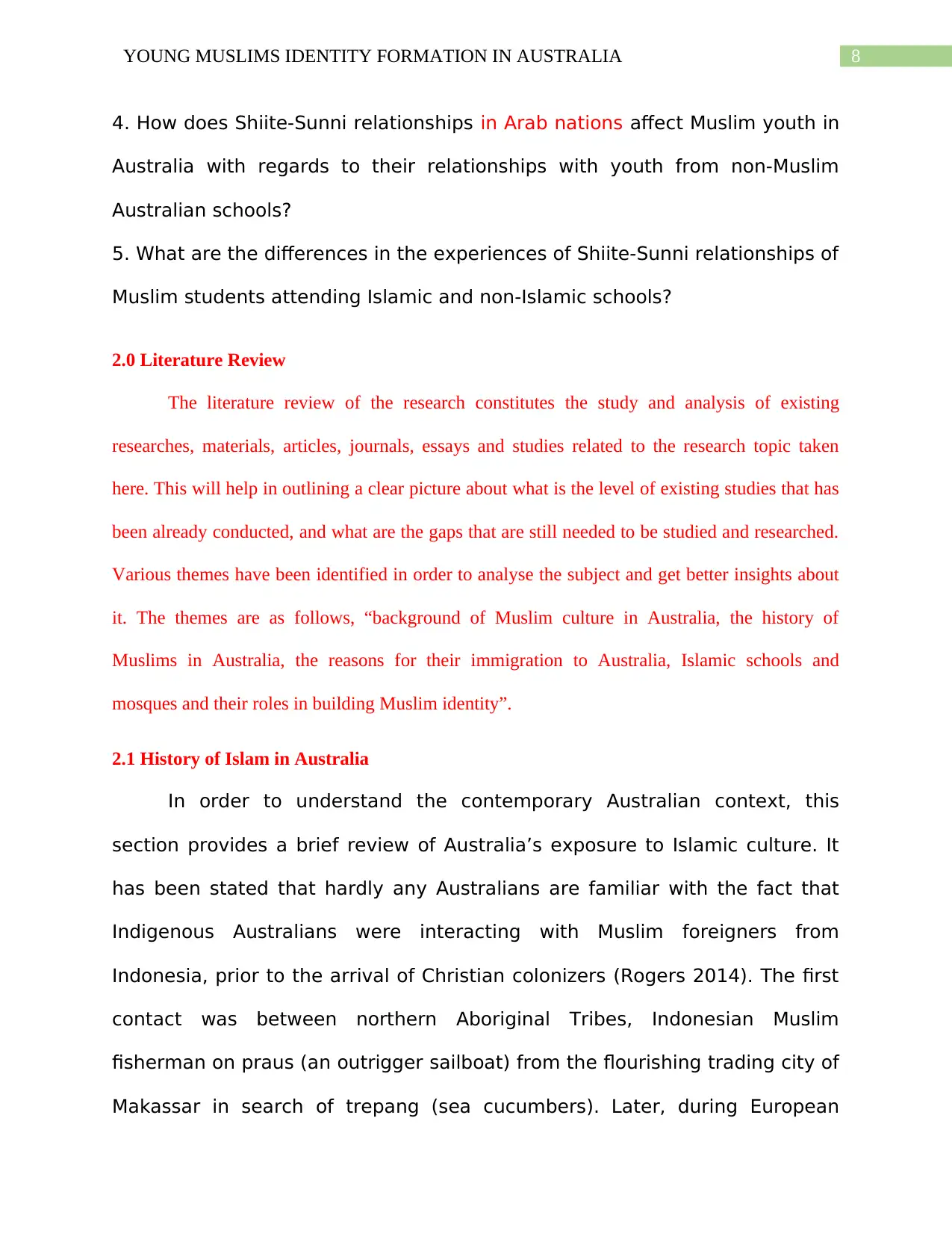
8YOUNG MUSLIMS IDENTITY FORMATION IN AUSTRALIA
4. How does Shiite-Sunni relationships in Arab nations affect Muslim youth in
Australia with regards to their relationships with youth from non-Muslim
Australian schools?
5. What are the differences in the experiences of Shiite-Sunni relationships of
Muslim students attending Islamic and non-Islamic schools?
2.0 Literature Review
The literature review of the research constitutes the study and analysis of existing
researches, materials, articles, journals, essays and studies related to the research topic taken
here. This will help in outlining a clear picture about what is the level of existing studies that has
been already conducted, and what are the gaps that are still needed to be studied and researched.
Various themes have been identified in order to analyse the subject and get better insights about
it. The themes are as follows, “background of Muslim culture in Australia, the history of
Muslims in Australia, the reasons for their immigration to Australia, Islamic schools and
mosques and their roles in building Muslim identity”.
2.1 History of Islam in Australia
In order to understand the contemporary Australian context, this
section provides a brief review of Australia’s exposure to Islamic culture. It
has been stated that hardly any Australians are familiar with the fact that
Indigenous Australians were interacting with Muslim foreigners from
Indonesia, prior to the arrival of Christian colonizers (Rogers 2014). The first
contact was between northern Aboriginal Tribes, Indonesian Muslim
fisherman on praus (an outrigger sailboat) from the flourishing trading city of
Makassar in search of trepang (sea cucumbers). Later, during European
4. How does Shiite-Sunni relationships in Arab nations affect Muslim youth in
Australia with regards to their relationships with youth from non-Muslim
Australian schools?
5. What are the differences in the experiences of Shiite-Sunni relationships of
Muslim students attending Islamic and non-Islamic schools?
2.0 Literature Review
The literature review of the research constitutes the study and analysis of existing
researches, materials, articles, journals, essays and studies related to the research topic taken
here. This will help in outlining a clear picture about what is the level of existing studies that has
been already conducted, and what are the gaps that are still needed to be studied and researched.
Various themes have been identified in order to analyse the subject and get better insights about
it. The themes are as follows, “background of Muslim culture in Australia, the history of
Muslims in Australia, the reasons for their immigration to Australia, Islamic schools and
mosques and their roles in building Muslim identity”.
2.1 History of Islam in Australia
In order to understand the contemporary Australian context, this
section provides a brief review of Australia’s exposure to Islamic culture. It
has been stated that hardly any Australians are familiar with the fact that
Indigenous Australians were interacting with Muslim foreigners from
Indonesia, prior to the arrival of Christian colonizers (Rogers 2014). The first
contact was between northern Aboriginal Tribes, Indonesian Muslim
fisherman on praus (an outrigger sailboat) from the flourishing trading city of
Makassar in search of trepang (sea cucumbers). Later, during European
⊘ This is a preview!⊘
Do you want full access?
Subscribe today to unlock all pages.

Trusted by 1+ million students worldwide
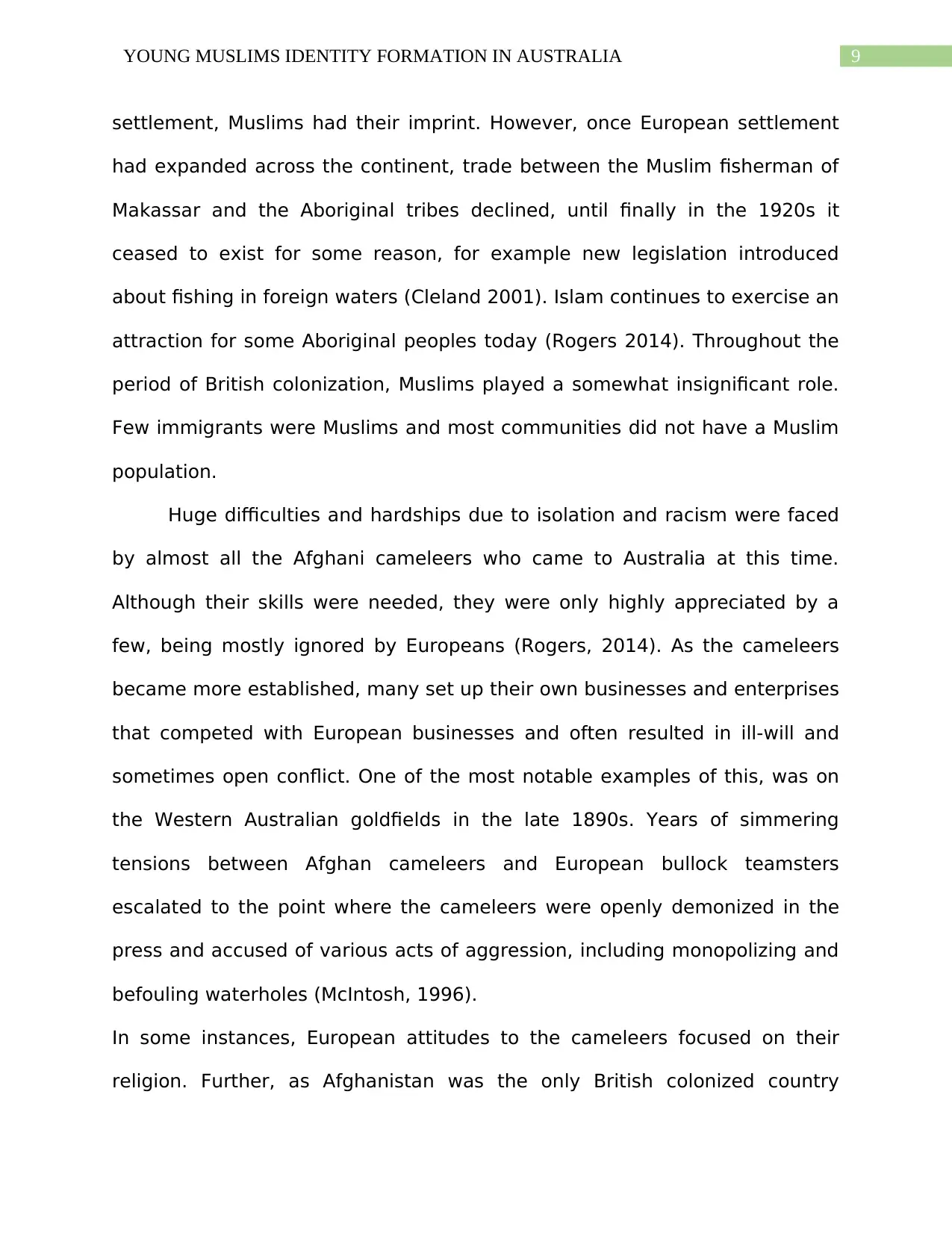
9YOUNG MUSLIMS IDENTITY FORMATION IN AUSTRALIA
settlement, Muslims had their imprint. However, once European settlement
had expanded across the continent, trade between the Muslim fisherman of
Makassar and the Aboriginal tribes declined, until finally in the 1920s it
ceased to exist for some reason, for example new legislation introduced
about fishing in foreign waters (Cleland 2001). Islam continues to exercise an
attraction for some Aboriginal peoples today (Rogers 2014). Throughout the
period of British colonization, Muslims played a somewhat insignificant role.
Few immigrants were Muslims and most communities did not have a Muslim
population.
Huge difficulties and hardships due to isolation and racism were faced
by almost all the Afghani cameleers who came to Australia at this time.
Although their skills were needed, they were only highly appreciated by a
few, being mostly ignored by Europeans (Rogers, 2014). As the cameleers
became more established, many set up their own businesses and enterprises
that competed with European businesses and often resulted in ill-will and
sometimes open conflict. One of the most notable examples of this, was on
the Western Australian goldfields in the late 1890s. Years of simmering
tensions between Afghan cameleers and European bullock teamsters
escalated to the point where the cameleers were openly demonized in the
press and accused of various acts of aggression, including monopolizing and
befouling waterholes (McIntosh, 1996).
In some instances, European attitudes to the cameleers focused on their
religion. Further, as Afghanistan was the only British colonized country
settlement, Muslims had their imprint. However, once European settlement
had expanded across the continent, trade between the Muslim fisherman of
Makassar and the Aboriginal tribes declined, until finally in the 1920s it
ceased to exist for some reason, for example new legislation introduced
about fishing in foreign waters (Cleland 2001). Islam continues to exercise an
attraction for some Aboriginal peoples today (Rogers 2014). Throughout the
period of British colonization, Muslims played a somewhat insignificant role.
Few immigrants were Muslims and most communities did not have a Muslim
population.
Huge difficulties and hardships due to isolation and racism were faced
by almost all the Afghani cameleers who came to Australia at this time.
Although their skills were needed, they were only highly appreciated by a
few, being mostly ignored by Europeans (Rogers, 2014). As the cameleers
became more established, many set up their own businesses and enterprises
that competed with European businesses and often resulted in ill-will and
sometimes open conflict. One of the most notable examples of this, was on
the Western Australian goldfields in the late 1890s. Years of simmering
tensions between Afghan cameleers and European bullock teamsters
escalated to the point where the cameleers were openly demonized in the
press and accused of various acts of aggression, including monopolizing and
befouling waterholes (McIntosh, 1996).
In some instances, European attitudes to the cameleers focused on their
religion. Further, as Afghanistan was the only British colonized country
Paraphrase This Document
Need a fresh take? Get an instant paraphrase of this document with our AI Paraphraser
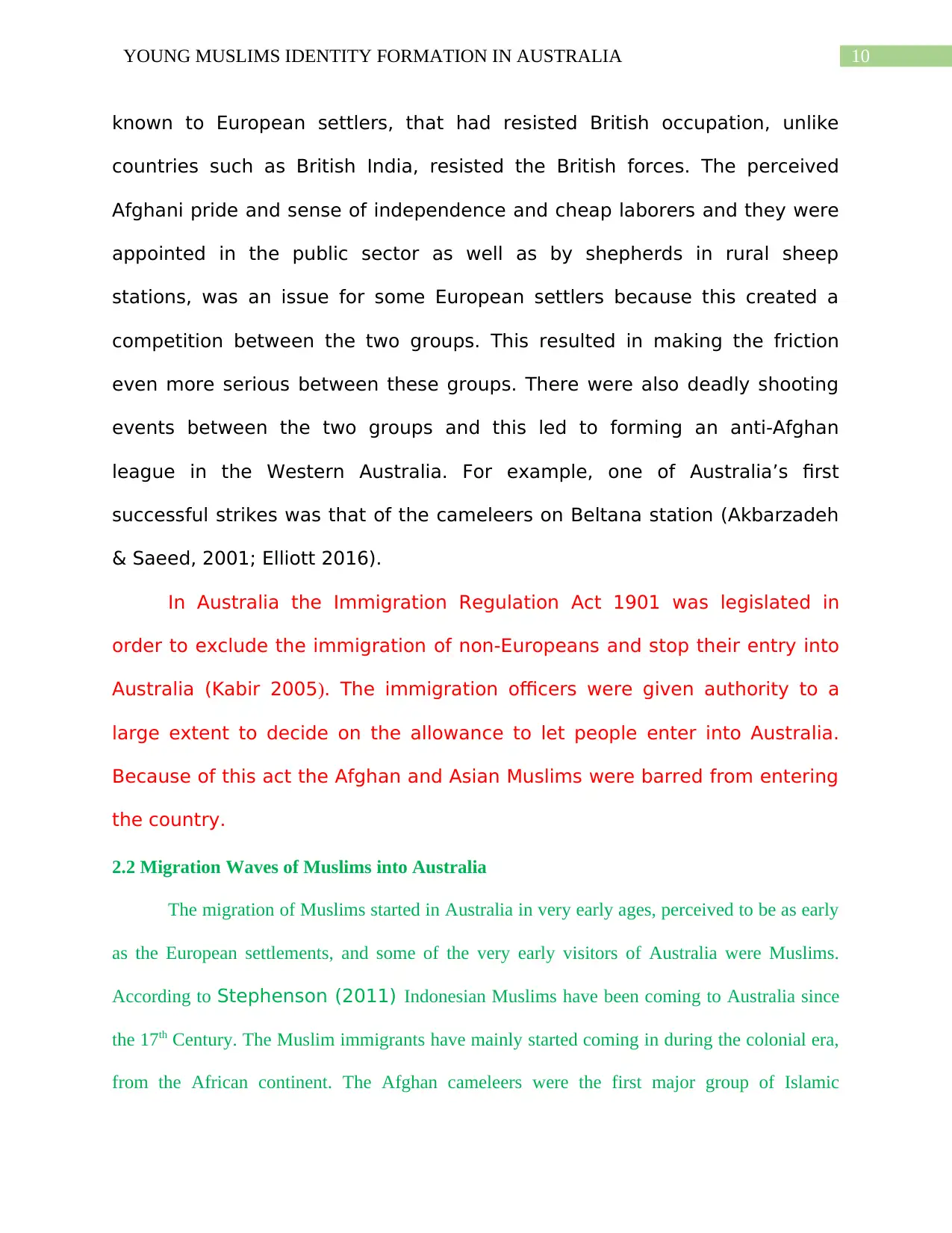
10YOUNG MUSLIMS IDENTITY FORMATION IN AUSTRALIA
known to European settlers, that had resisted British occupation, unlike
countries such as British India, resisted the British forces. The perceived
Afghani pride and sense of independence and cheap laborers and they were
appointed in the public sector as well as by shepherds in rural sheep
stations, was an issue for some European settlers because this created a
competition between the two groups. This resulted in making the friction
even more serious between these groups. There were also deadly shooting
events between the two groups and this led to forming an anti-Afghan
league in the Western Australia. For example, one of Australia’s first
successful strikes was that of the cameleers on Beltana station (Akbarzadeh
& Saeed, 2001; Elliott 2016).
In Australia the Immigration Regulation Act 1901 was legislated in
order to exclude the immigration of non-Europeans and stop their entry into
Australia (Kabir 2005). The immigration officers were given authority to a
large extent to decide on the allowance to let people enter into Australia.
Because of this act the Afghan and Asian Muslims were barred from entering
the country.
2.2 Migration Waves of Muslims into Australia
The migration of Muslims started in Australia in very early ages, perceived to be as early
as the European settlements, and some of the very early visitors of Australia were Muslims.
According to Stephenson (2011) Indonesian Muslims have been coming to Australia since
the 17th Century. The Muslim immigrants have mainly started coming in during the colonial era,
from the African continent. The Afghan cameleers were the first major group of Islamic
known to European settlers, that had resisted British occupation, unlike
countries such as British India, resisted the British forces. The perceived
Afghani pride and sense of independence and cheap laborers and they were
appointed in the public sector as well as by shepherds in rural sheep
stations, was an issue for some European settlers because this created a
competition between the two groups. This resulted in making the friction
even more serious between these groups. There were also deadly shooting
events between the two groups and this led to forming an anti-Afghan
league in the Western Australia. For example, one of Australia’s first
successful strikes was that of the cameleers on Beltana station (Akbarzadeh
& Saeed, 2001; Elliott 2016).
In Australia the Immigration Regulation Act 1901 was legislated in
order to exclude the immigration of non-Europeans and stop their entry into
Australia (Kabir 2005). The immigration officers were given authority to a
large extent to decide on the allowance to let people enter into Australia.
Because of this act the Afghan and Asian Muslims were barred from entering
the country.
2.2 Migration Waves of Muslims into Australia
The migration of Muslims started in Australia in very early ages, perceived to be as early
as the European settlements, and some of the very early visitors of Australia were Muslims.
According to Stephenson (2011) Indonesian Muslims have been coming to Australia since
the 17th Century. The Muslim immigrants have mainly started coming in during the colonial era,
from the African continent. The Afghan cameleers were the first major group of Islamic
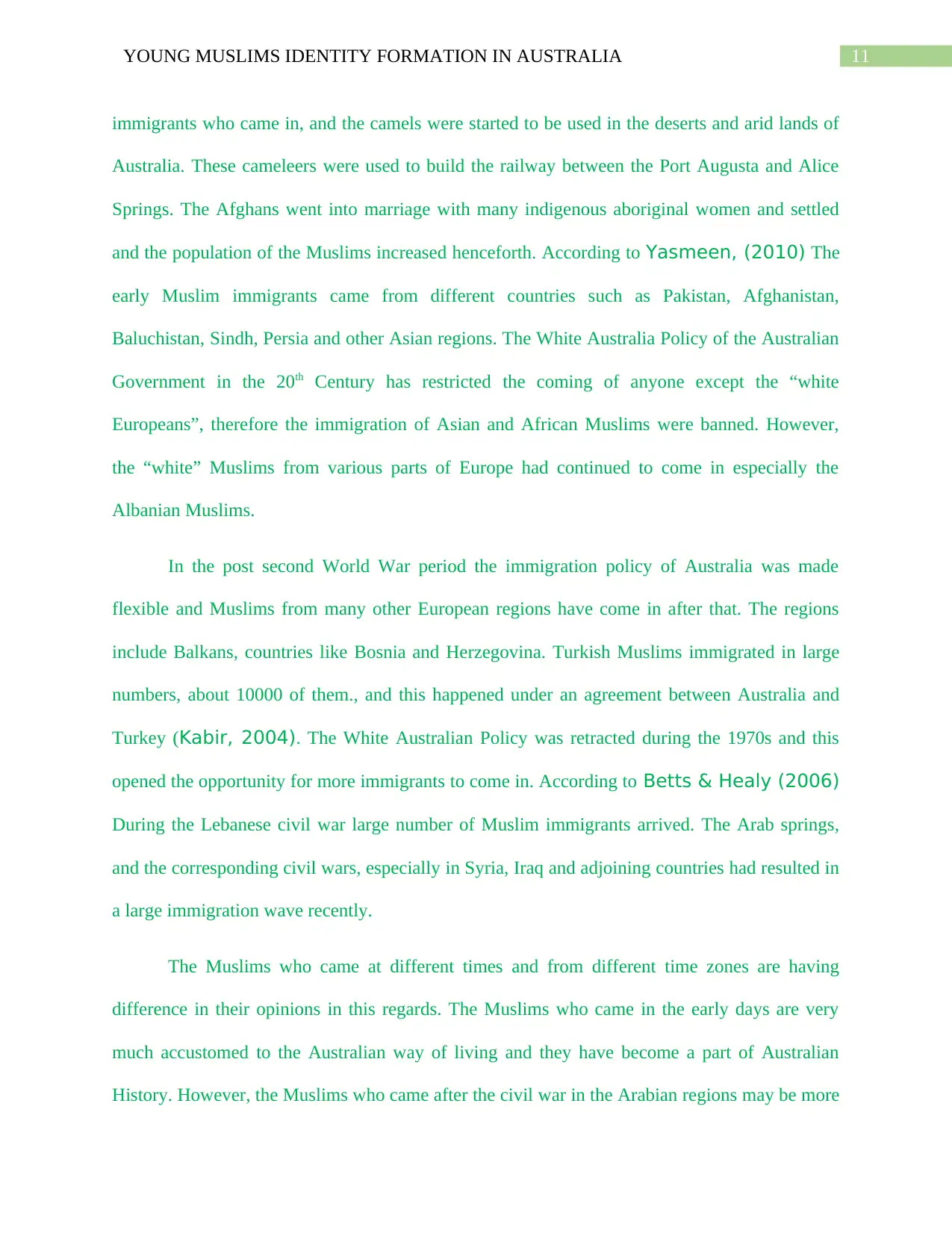
11YOUNG MUSLIMS IDENTITY FORMATION IN AUSTRALIA
immigrants who came in, and the camels were started to be used in the deserts and arid lands of
Australia. These cameleers were used to build the railway between the Port Augusta and Alice
Springs. The Afghans went into marriage with many indigenous aboriginal women and settled
and the population of the Muslims increased henceforth. According to Yasmeen, (2010) The
early Muslim immigrants came from different countries such as Pakistan, Afghanistan,
Baluchistan, Sindh, Persia and other Asian regions. The White Australia Policy of the Australian
Government in the 20th Century has restricted the coming of anyone except the “white
Europeans”, therefore the immigration of Asian and African Muslims were banned. However,
the “white” Muslims from various parts of Europe had continued to come in especially the
Albanian Muslims.
In the post second World War period the immigration policy of Australia was made
flexible and Muslims from many other European regions have come in after that. The regions
include Balkans, countries like Bosnia and Herzegovina. Turkish Muslims immigrated in large
numbers, about 10000 of them., and this happened under an agreement between Australia and
Turkey (Kabir, 2004). The White Australian Policy was retracted during the 1970s and this
opened the opportunity for more immigrants to come in. According to Betts & Healy (2006)
During the Lebanese civil war large number of Muslim immigrants arrived. The Arab springs,
and the corresponding civil wars, especially in Syria, Iraq and adjoining countries had resulted in
a large immigration wave recently.
The Muslims who came at different times and from different time zones are having
difference in their opinions in this regards. The Muslims who came in the early days are very
much accustomed to the Australian way of living and they have become a part of Australian
History. However, the Muslims who came after the civil war in the Arabian regions may be more
immigrants who came in, and the camels were started to be used in the deserts and arid lands of
Australia. These cameleers were used to build the railway between the Port Augusta and Alice
Springs. The Afghans went into marriage with many indigenous aboriginal women and settled
and the population of the Muslims increased henceforth. According to Yasmeen, (2010) The
early Muslim immigrants came from different countries such as Pakistan, Afghanistan,
Baluchistan, Sindh, Persia and other Asian regions. The White Australia Policy of the Australian
Government in the 20th Century has restricted the coming of anyone except the “white
Europeans”, therefore the immigration of Asian and African Muslims were banned. However,
the “white” Muslims from various parts of Europe had continued to come in especially the
Albanian Muslims.
In the post second World War period the immigration policy of Australia was made
flexible and Muslims from many other European regions have come in after that. The regions
include Balkans, countries like Bosnia and Herzegovina. Turkish Muslims immigrated in large
numbers, about 10000 of them., and this happened under an agreement between Australia and
Turkey (Kabir, 2004). The White Australian Policy was retracted during the 1970s and this
opened the opportunity for more immigrants to come in. According to Betts & Healy (2006)
During the Lebanese civil war large number of Muslim immigrants arrived. The Arab springs,
and the corresponding civil wars, especially in Syria, Iraq and adjoining countries had resulted in
a large immigration wave recently.
The Muslims who came at different times and from different time zones are having
difference in their opinions in this regards. The Muslims who came in the early days are very
much accustomed to the Australian way of living and they have become a part of Australian
History. However, the Muslims who came after the civil war in the Arabian regions may be more
⊘ This is a preview!⊘
Do you want full access?
Subscribe today to unlock all pages.

Trusted by 1+ million students worldwide
1 out of 36
Your All-in-One AI-Powered Toolkit for Academic Success.
+13062052269
info@desklib.com
Available 24*7 on WhatsApp / Email
![[object Object]](/_next/static/media/star-bottom.7253800d.svg)
Unlock your academic potential
Copyright © 2020–2025 A2Z Services. All Rights Reserved. Developed and managed by ZUCOL.